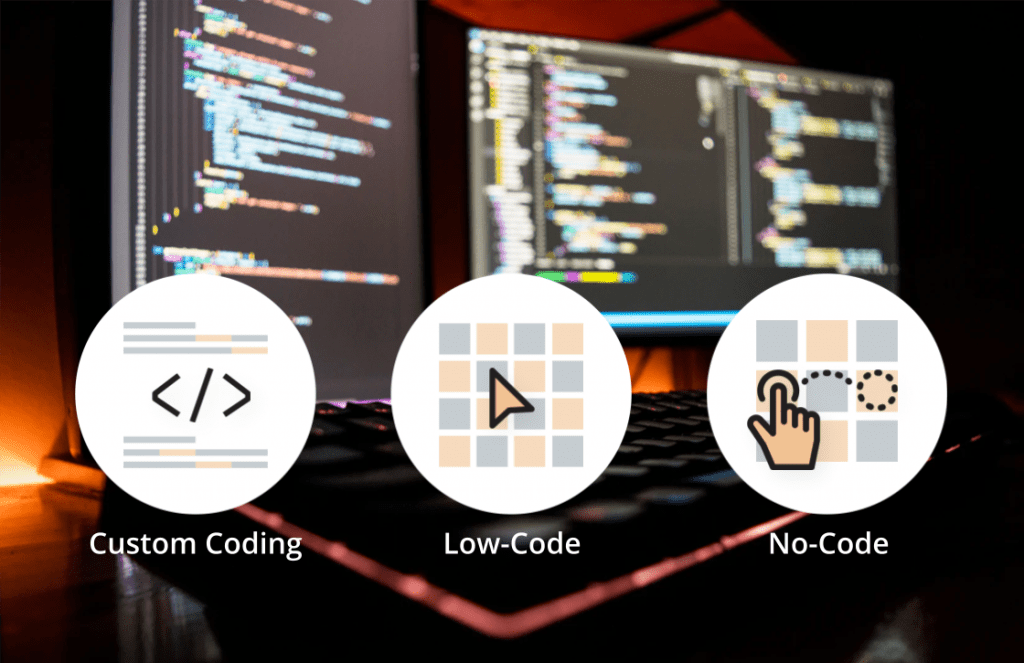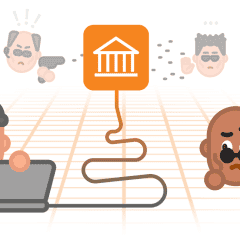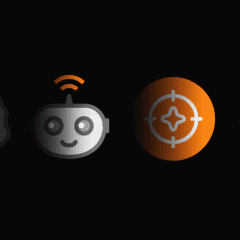If you’ve heard it once, you’ve heard it a million times: If something seems too good to be true, then it probably is. A perfect house at an affordable price, a no-hassle job with top-exec perks and salary, or a diet that says you can eat anything you want and still look like a model. This is the stuff of dreams. So, what if we told you it’s possible to develop a software program, web app, or mobile app for your company without hiring a programmer and without spending weeks or months learning to code yourself? What if there is a low code tool? Or a no code tool that requires no coding at all?
Think it’s not possible? Does engineering require coding? It is possible, and you don’t have to code to create a better customer experience in telecom. Read on to find out how low- and no-code development is implemented in telecommunications. And at PortaOne.
A No Code and Low Code History in Telecom Innovation
Let’s set the scene. For all you ancient history lovers out there, we’ll start with a quick summary of the development of … well, development itself. Or, at least, of software development. You can’t understand telecom innovation until you understand software innovation, after all.
We won’t get into all the nitty gritty, since for the purposes of this post we’re going to focus on the here and now. But here’s the gist.
You might be surprised to hear that the 1940s brought about the genesis of computing languages. But, back then, it was extremely complicated and inefficient.
In 1954, IBM came along with FORTRAN (FORMula TRANslator). That brought computer programming to people who worked in technical fields outside of strict computing, for instance mathematicians and scientists. Next up was COBOL (COmmon, Business-Oriented Language), which further opened doors. It spread programming to those even outside of science and math.
The next big breakthrough came in the 1970s with the creation of ‘C’. This was a quantum leap forward, because C was written in English syntax and offered more flexibility. That meant it was possible to use it across multiple applications.
The No-Code Development Race Begins
Since then, several other technologies have attempted to align with human languages to allow for conceptualization sans extreme coding. This includes, for example, fourth-generation languages (4GL), computer-assisted software engineering (CASE) tools, and early rapid application development (RAD) tools.
Andriy Zhylenko, CEO of PortaOne, received training himself in SQLWindows during his university days in the mid 1990s. SQLWindows is a type of CASE that promised to make the need for programmers obsolete within a few years. (This was only the start of the no code vs full code debate. Some folks think this is why developers hate low code, but in our experience, embracing low code is embracing agile, and developers love agile – at least those on our team.)
Twenty-five-plus years on, programmer obsolescence is still definitely NOT the case.
And on and on through the years came more and larger attempts at creating a comprehensive computer language. But all fell short, whether that was due to high expectations, not following best practices, or increased security threats.
Low Code RAD as a Starting Point for NCDPs and LCDPs
And so we enter the modern era, in which new RAD low code tools have come into existence. These tools are, thankfully, learning from – and moving past – their predecessors’ mistakes.
No-code development platforms (NCDPs) and low-code development platforms (LCDPs) are both instruments of RAD. This method is now favored over the previously preferred Waterfall method, which required reengineering each time a new change or update was needed. That meant lots of strict planning, along with a strict adherence to that plan if you wanted it to actually take effect. RAD, however, allows for the quick release of prototypes and iterations with the use of software and user feedback. It relies on building, demonstrating, and refining in multiple successions, until the desired outcome is established.
Low code RAD became popular in the 1990s and the 2000s because it allowed companies to migrate processes from paper to digital in a more streamlined way. Both platforms have since further simplified the process thanks to cloud-based technologies.
What Does No Code, Low Code Mean?
No-code and low-code are platforms that allow non-experts to create software programs, including web apps, mobile apps, and back-office apps. And all with little or no help from your IT department, and no outsourcing to expert developers.
Those in the know call the laypeople who create these programs “citizen developers.” Why? Because they can be from a whole host of backgrounds, none of which need to be in software development. What do low code and no code applications look like? Basically, the main components of no-code and low-code possess or employ visual modeling, reusability, monitoring, reporting, robust functionality, and cross-platform accessibility.
One of the easiest examples to understand is the standard CMS platforms that many use to run their websites, such as WordPress, Wix, or Joomla. These platforms were initially created by a team of experienced software developers. It took months, or in some cases years, to create the original prototypes and then get them off the ground and running.
Slow to Market, Fast to Adoption
But when the final product was ready, the end users – the aforementioned citizen developers – now had the power to create their own websites quickly and easily. Today, users can simply create an account, select a customizable template, and use drag-and-drop or point-and-click functions to design their own unique website. None of these non-technical citizens are writing any lines of code, yet they now have nice-looking, functional websites that they created and launched themselves. And they did it in very little time.
And here’s another example of how these tools are helping people. Say you have kids at home who need something to do. With a tool like Scratch, a wonderful no-code platform created by the MIT Media Lab, you can let your children create their own video games, animations, and videos, all by themselves. And all with the same premise of drag-and-drop functionality.
What Is the Difference Between No-Code, Low-Code and High-Code?

While the line between NCDP (no code development platform) and LCDP (low code development platform) is faint, it does exist. The biggest difference is about who is actually doing the application creation. For no-code, it’s possible for any end user in a given business to use the platform to create a working program.
In the case of low-code, however, this is a little bit trickier for the true layperson. True, you don’t have to be an experienced developer (or even to be fluent in any particular coding language). But you do need to be able to think like one.
A recent Gartner survey showed that 66% of LCDP users are professional developers from an enterprise IT department. But, really, anyone who has a basic, high-school level computer science knowledge of algorithms and code and can grasp the fundamental concepts of IT, such as what an API is, will be able to successfully work with a low-code platform.
So a low-code development platform has two benefits over traditional coding. First, it allows a professional developer to produce significantly more results. And, second, it allows people with basic IT knowledge to create a working application they otherwise would not be able to.
Let’s break it down further. In the next section, we’ll walk through a closer look at all of the differences between no-code, low-code, and high-code tools.
No Code Meaning
Accessible to any end user, no-code means anyone on the team can be an app creator! With core design functions based on a model-driven, declarative approach with a drag and drop interface, an NCDP shortens development time and lowers cost. (Particularly so since citizen developers don’t come with the price tag of trained experts.) No-code also works for all platforms: web, mobile, and cloud.
What Are the Pros of No-Code Tools?
- Virtually no chance of coding errors
- Easy updating
- Speed and ease of development
- Saves on time and money by eliminating the need for software developers
And What Are the Cons of No-Code Tools?
- Less control over security (or so folks think… more one why this may not be true later)
- Less control over sustainability
What Are Some Uses for No-Code Tools?
- Digitize processes with cloud-based mobile apps
- Data capture
- Workflows
- Integrating enterprise resource planning (telecom ERP) tools (What is an ERP system in telecommunications? Do we have another no-code-low-code blog post for you!)
What Are Some No-Code Examples?
- Mailchimp’s all-in-one marketing platform
- Toy Doctor by Voiceflow’s voice app
- Turtle by Typeform
- PortaOne Workflows
The Take-Away from Telecoms No Code
NCDPs are a great way to save money and time, because telecom companies are no longer reliant on finding professional software developers to create every last line of code. They can also quickly launch new VAS (value added services) and new versions of an app. Another benefit: no-code can be used across multiple platforms at once, which saves time in building web and mobile versions. It also frees up experienced developers for more important tasks, such as automation and security.
Low Code Meaning
Low-code requires someone with basic knowledge of coding languages and/or the processes of coding. The core design is based on hard code used to specify core architecture. Typical development time can range from multiple weeks to a few months. And costs are slightly higher than no-code but considerably less than high-code. Low-code works across multiple platforms including web, mobile and cloud, just as no-code does.
What Are the Pros of Low-Code Tools?
- Relatively small chance of coding errors
- Easy software updating
- Great for prototyping
- Accelerates development
- Reduces need for software developers
- Reduces costs of setup, training, deployment, and maintenance
- Flexible; allows for future customization
- Cuts out need for multi-device software creation (comes standard)
And What Are the Cons of Low-Code Tools?
- Not as much suitability for large-scale applications
- Less degree of cost-efficiency than no-code
- Higher chance of unsupported software
What Are Some Uses for No-Code Tools?
- Customized applications for a company’s individual needs
- Rapid creation of working applications
What Are Some No-Code Examples?
- Kermit SaaS app
- PortaOne iPaaS
- PortaOne PBX Onboarding Wizard
- PayPal’s CRM
The Take-Away from Telecoms Low Code
Much like no-code, LCDPs save companies time and money. (Perhaps not quite as much as NCDPs, but considerable compared to traditional, customized coding.) LCDPs work across multiple platforms and are much more flexible when future changes are needed. They also allow businesses to create customized applications at a much more rapid pace than high-code.
High Code Meaning
High code requires highly experienced software developers with knowledge of one or more languages. The core design is one based on writing complete programs and apps from scratch. Development time can range from several months to upwards of a year or even more in some instances. Due to the need for expert developers and the time involved, high-code comes with high costs. And, generally, each app is developed for one platform.
What Are the Pros of High-Code Tools?
- Open-ended solutions
- Can create apps with high levels of specialized interactivity
- Allows you to find and fix bugs
And What Are the Cons of High-Code Tools?
- Labor intensive, drawing resources from other projects
- Cost intensive
- Lengthy process
- High chance and likelihood of coding errors
- Requires additional development and extensive support
What Are Some Uses for High-Code Tools?
- When a highly customizable solution is needed
- When your in-house platform does not require any collaboration with or connection to other (external) apps
What Are Some High-Code Examples?
- NHS user platform by Icreon
- Military Enlistment platform by Tandem
- BeerTap app by openXcell
- Developing an app using PortaSwitch REST API
The Take-Away from Telecoms High-Code
High, or custom coding, is still the way to go for companies that wish to create highly specialized apps for themselves or their customers. It is much more time, and therefore labor, intensive and requires having experienced developers on staff. However, for specialized activities or in-house solutions, this may be the best solution. If, that is, the company can stay on top of future needs regarding updates and maintenance.
Our Opinion on the Low Code No Code Debate

If you’re worried that NCDPs and LCDPs could potentially make your apps and websites more vulnerable, that’s understandable. Yes, the products of these tools are built by non-technical users. But telecoms and their customers can rest assured that low code and no code telecommunications software is actually even safer.
In reality, custom code actually runs a higher risk of being a security threat down the road than NCDP products do. That’s because these tools have been created and validated across multiple applications. A no-code solution provides a barrier between the platform and what the end user can actually modify.
While there’s limited integration with low-code and no-code platforms, this should not lead you to an immediate “no” for either of them. For many telecom companies, the gains significantly outweigh the losses when it comes to a bit of customization.
So, that’s the low or no code vs full code debate. What about the low code vs no code debate? This is where low-code can edge out over no-code. Bringing back that earlier CMS example, it’s still possible to make changes. You can hire a software developer to help you customize your template so that it fits what you need and has all of the functionalities that might be missing from the standard-issue one.
And the Knock-on Effects of Low Code and No Code in Telecom?
Some also claim that NCDPs and LCDPs will make traditional telecom developers obsolete. The worry is that this will dry up what has become a growing industry and an excellent career for leagues of professional developers around the world. Estimates by DAXX say that the number of developers worldwide has nearly doubled from 2018 to 2021 – from almost 24 million to 45 million.
But in truth, this is simply another misunderstood fact. How can telecommunications skills be improved by 2024? By freeing traditional software developers from all the busywork and maintenance their jobs used to require. This trend is only going to increase the value of telecom software developers as highly skilled workers. Now, developers can spend their time on improving security, advancing technology, and coming up with more complex and innovative solutions.
Why Does the Low Code vs No Code vs High Code Debate in Telecom Matter?
In fact, one of the largest problems currently weighing on companies large and small is the shortage of experienced developers. And with the variety of programming languages now available, this has only gotten worse. For example, if you task a good Python developer with coding in, say, Java, their performance during the learning period (which may take months, if not years!) will be low, and the code quality will be poor. Plus, it is very likely they will complain, or even hate the process so much that they leave.
What does this all translate to? An even tighter shortage of people who have the very specific skill sets needed to create hundreds or thousands of new or enhanced software applications. All turning a time when we are revolutionizing telecom operations. This is not the time for a technology skill gap. We need to foster those telecommunications skills in the development world, and freeing up the ability to create, rather than troubleshoot, is one way to do that.
The challenge for us in maintaining AI leadership is the constant struggle to find and retain talent in this high-demand tech space.
– Jeff Reihl, Chief Technology Officer, LexisNexis
Larger, more established telco corporations that boast of their longevity are the ones suffering the most from this shortage. Their current workflows are full of outdated and legacy systems that require loads of upkeep and maintenance. Without development and digital transformation, organizations will be left in the dust.

What Do the Stats Say About LCDP and NCDP?
The IDC (International Data Corporation) reports that total global spending on digital transformation (DX) will reach upwards of $3.9 trillion by 2027. “Customer Experience, Innovation, and Efficiency are leading to business models that are boosting both productivity and profitability for businesses,” they write.
Companies are rushing to transform their internal and external facing systems to increase efficiency, encourage innovation, and decrease costs. Gartner reckons that “the low-code application platform market is set to grow at a CAGR of more than 20% to roughly $18 billion in 2026.” They also estimate that, by 2024, nearly 75% of bigger businesses will be using upward of four low-code development tools. And all created by citizen development initiatives
How PortaOne Uses Low-Code and No-Code
PortaOne recognizes the need for our customers to have more agile, less time-consuming, and easier solutions that work for them, rather than against them. We believe that a key answer to this problem is the implementation of low-code solutions. (What is agile methodology in telecommunications? We have some thoughts on that, too.)
For a long time our customers asked us for a tool that will integrate our business solutions with other widely used applications – for example, linking PortaBilling with Quickbooks. In particular, they have asked for an easy-to-use UI for data entry for onboarding new cloud PBX clients. That was the origin of Boomi-based PortaOne Workflows. If you want a deep dive into the range of uses cases and customer success stories that have since followed, check out our Workflows video playlist on YouTube for some pretty amazing inspiration.
In the meantime, if you’re interested in evaluating your integration needs and getting advice on which integration tool will work the best for you, get in touch with us today.











